Order Hemiptera ( True Bugs, Froghoppers, Leafhoppers, Planthoppers, Treehoppers, Cicadas, Aphids, Scales, Whiteflies, & Mealybugs) in the Christopher B. Smith Preserve
Order Hemiptera Characteristics: All hemipterans have gradual metamorphosis (egg, nymph, and adult stages). Hemipterans live in a variety of habitats, including terrestrial and aquatic.
Although body style is extremely diverse among the thousands of species, all have syringe-like beaks used to suck liquefied food. The beak is composed of four narrow blades. One pair of blades is used for cutting and the other pair for spitting saliva and sucking.
Taxonomists disagree in the number of suborders of hemipterans. Some say two, others say up to four or more. This field guide will discuss three suborders of Hemipterans found in the Smith Preserve: 1) Suborder Heteroptera was previously called Hemiptera. Hemiptera means "different wings." In this suborder, the base of the rostrum is on the ventral, anterior portion of the head. 2) Suborder Auchenorrhyncha was previously part of Order Homoptera. 3) Suborder Sternorrhyncha was also previously part of Order Homptera. Homoptera means "uniform wings;" wings are held roof-like over the abdomen at rest. The base of the rostrum is on the ventral, posterior of the head. These insects eat plant sap (sugar water). Individuals spend most of the time eating. During the injection of saliva, plant cells are injured; leaves curl and turn brown. Some of these homopterans also carry plant diseases.
Suborder Heteroptera (Hemiptera): There are 8000 species of hemipterans in Florida. At rest, wings are folded flat over the back, with the forewings protecting the hind wings. Forewings are divided into two sections, one is thick and protective, the other, a thin membrane. Because of this division, "Hemiptera" means "half-wing." As seen in the first photograph, the scutellum, a plate of the thorax between the bases of the forewings, is triangular. This characteristic is used to identify this suborder.
As shown in the second photograph, the beak (mouth) is folded under the head and body when not is use. It extends forward for feeding.
Stink glands exist on most species near the bases of the middle pair of legs. The chemicals emitted by these glands are used as a defense against predators.
Suborder Auchenorrhyncha (Homoptera): As shown at left, a member of this suborder has well-developed wings and jumping legs. They are capable of acoustic communication. This suborder includes cicadas, froghoppers, leafhoppers, planthoppers and treehoppers.
Suborder Sternorrhyncha (Homoptera): This suborder includes aphids, scale insects, mealybugs, whiteflies, and psyllids. Most show reduction in structural complexity and are relatively inactive. For many, the nymphal stage is protected, as in scales and galls.
Interactions in the Smith Preserve: Some hemipterans are herbivores, others are insect predators. In both cases, the beak pierces the tissue, salivary secretions break down the tissue, and the hemipteran sucks out the liquids. As a result of their feeding behavior, hemipterans keep populations of other organisms in check. Members of this order provide food for larger animals.
Suborder |
Family |
Species Name |
Common Name |
Heteroptera (Hemiptera) |
Alydidae |
Hyalymenus longispinus ? |
|
Heteroptera (Hemiptera) |
Alydidae |
Megatotomus sp. |
|
Heteroptera (Hemiptera) |
Alydidae |
Megatotomus sp. |
|
Heteroptera (Hemiptera) |
Alydidae |
Unknown |
|
Heteroptera (Hemiptera) |
Anthocoridae |
Unknown |
|
Heteroptera (Hemiptera) |
Belostomatidae |
Belostoma minor |
|
Heteroptera (Hemiptera) |
Blissidae |
Ischnodemus sp. |
|
Heteroptera (Hemiptera) |
Coreidae |
Acanthocephala femorata |
|
Heteroptera (Hemiptera) |
Coreidae |
Leptoglossus gonagra |
|
Heteroptera (Hemiptera) |
Coreidae |
Namacus annulicornis |
|
Heteroptera (Hemiptera) |
Coreidae |
Unknown |
|
Heteroptera (Hemiptera) |
Cydninae |
Unknown |
|
Heteroptera (Hemiptera) |
Gerridae |
Limnogonus sp. |
|
Heteroptera (Hemiptera) |
Gerridae |
Limnogonus franciscanus |
|
Heteroptera (Hemiptera) |
Gerridae |
Limogonus recens |
|
Heteroptera (Hemiptera) |
Gerridae |
Neogerris hesione |
|
Heteroptera (Hemiptera) |
Gerridae |
Rheumatobates sp. |
|
Heteroptera (Hemiptera) |
Gerridae |
Rheumatobates tenuipes |
|
Heteroptera (Hemiptera) |
Hydrometridae |
Hydrometra australis |
|
Heteroptera (Hemiptera) |
Lygaeidae |
Nysius sp. |
|
Heteroptera (Hemiptera) |
Mesoveliidae |
Mesovelia amoena |
|
Heteroptera (Hemiptera) |
Mesoveliidae |
Mesovelia mulsanti |
|
Heteroptera (Hemiptera) |
Micronectidae |
Micronecta ludibunda |
|
Heteroptera (Hemiptera) |
Miridae |
Unknown |
|
Heteroptera (Hemiptera) |
Miridae |
Unknown |
|
| Heteroptera (Hemiptera) | Miridae | Unknown-Tribe Mirini | Plant Bug |
Heteroptera (Hemiptera) |
Miridae |
Unknown |
|
Heteroptera (Hemiptera) |
Miridae |
Phytocoris sp. |
|
Heteroptera (Hemiptera) |
Nepidae |
Ranatra australis |
|
Heteroptera (Hemiptera) |
Pentatomidae |
Stiretrus anchorago |
|
Heteroptera (Hemiptera) |
Pentatomidae |
Unknown |
|
Heteroptera (Hemiptera) |
Reduviidae |
Phymata mystica |
|
Heteroptera (Hemiptera) |
Reduviidae |
Stenolemus |
|
Heteroptera (Hemiptera) |
Reduviidae |
Unknown |
|
Heteroptera (Hemiptera) |
Rhyparochromidae |
Froeschneira sp. |
|
Heteroptera (Hemiptera) |
Rhyparochromidae |
Pseudopachybrachius sp. |
|
Heteroptera (Hemiptera) |
Rhyparochromidae |
Ozophora sp. ? |
|
Heteroptera (Hemiptera) |
Rhyparochromidae |
Unknown |
|
Heteroptera (Hemiptera) |
Scutelleridae |
Sphyrocoris obliquus |
|
Heteroptera (Hemiptera) |
Thyreocoridae |
Unknown |
|
Heteroptera (Hemiptera) |
Tingidae |
Corythucha sp. |
|
Heteroptera (Hemiptera) |
Tingidae |
Minitingis sp. |
|
| Heteroptera (Hemiptera) | Tingidae | Unknown | Lace Bug Nymph |
Heteroptera (Hemiptera) |
Veliidae |
Microvelia |
|
Heteroptera (Hemiptera) |
Unknown |
Unknown |
|
Heteroptera (Hemiptera) |
Unknown |
Unknown |
|
Auchenorrhyncha (Homoptera) |
Acanaloniidae |
Acanalonia sp. |
|
Auchenorrhyncha (Homoptera) |
Acanaloniidae |
Acanalonia pumila (Possibly) |
|
Auchenorrhyncha (Homoptera) |
Acanaloniidae |
Acanalonia servillei |
|
Auchenorrhyncha (Homoptera) |
Cercopidae |
Prosapia bicincta |
|
Auchenorrhyncha (Homoptera) |
Cercopidae |
Clastoptera xanthocephala |
|
Auchenorrhyncha (Homoptera) |
Cicadellidae |
Agallia sp. |
|
Auchenorrhyncha (Homoptera) |
Cicadellidae |
Baldulus tripsaci |
|
Auchenorrhyncha (Homoptera) |
Cicadellidae |
Erasmoneura vulnerata |
|
Auchenorrhyncha (Homoptera) |
Cicadellidae |
Graminella sonora |
|
Auchenorrhyncha (Homoptera) |
Cicadellidae |
Graminella villica |
|
Auchenorrhyncha (Homoptera) |
Cicadellidae |
Jikradia olitoria |
|
Auchenorrhyncha (Homoptera) |
Cicadellidae |
Gyponana tenella |
|
Auchenorrhyncha (Homoptera) |
Cicadellidae |
Hortensia similis |
|
Auchenorrhyncha (Homoptera) |
Cicadellidae |
Scaphytopius sp. |
|
Auchenorrhyncha (Homoptera) |
Cicadellidae |
Protalebrella brasiliensis |
|
Auchenorrhyncha (Homoptera) |
Cicadellidae |
Unknown Species |
|
Auchenorrhyncha (Homoptera) |
Cicadellidae |
Unknown Species |
|
Auchenorrhyncha (Homoptera) |
Cicadellidae |
Unknown Species |
|
Auchenorrhyncha (Homoptera) |
Cicadellidae |
Cumora furcata |
|
Auchenorrhyncha (Homoptera) |
Cicadellidae |
Unknown Species |
|
Auchenorrhyncha (Homoptera) |
Cicadidae |
Neocicada hieroglyphica var. johannis |
|
Auchenorrhyncha (Homoptera) |
Cixiidae |
Haplaxius lunatus |
|
Auchenorrhyncha (Homoptera) |
Cixiidae |
Haplaxius sp. |
|
Auchenorrhyncha (Homoptera) |
Delphacidae |
Pissonotus sp. |
|
Auchenorrhyncha (Homoptera) |
Delphacidae |
Toya idonea |
|
Auchenorrhyncha (Homoptera) |
Delphacidae |
Unknown Species |
|
| Auchenorrhyncha (Homoptera) | Delphacidae | Unknown Species | Delphacid Planthopper |
Auchenorrhyncha (Homoptera) |
Derbidae |
Cedusa sp. |
|
Auchenorrhyncha (Homoptera) |
Derbidae |
Cedusa sp. |
|
Auchenorrhyncha (Homoptera) |
Derbidae |
Omolicna joi |
|
Auchenorrhyncha (Homoptera) |
Flatidae |
Flatoidinus punctatus |
|
Auchenorrhyncha (Homoptera) |
Flatidae |
Melormenis basalis |
|
Auchenorrhyncha (Homoptera) |
Flatidae |
Ormenaria rufifascia |
|
Auchenorrhyncha (Homoptera) |
Membracidae |
Cyrtolobus rufulus |
|
Auchenorrhyncha (Homoptera) |
Membracidae |
Stictocephala lutea |
|
Auchenorrhyncha (Homoptera) - Superfamily Fulgoroidea |
Unknown Family |
Unknown |
|
Auchenorrhyncha (Homoptera) - Superfamily Fulgoroidea |
Unknown Family |
Unknown |
|
Auchenorrhyncha (Homoptera) |
Flatidae |
Unknown |
|
Sternorrhyncha (Homoptera) |
Aleyrodidae |
Unknown |
|
Sternorrhyncha (Homoptera) |
Aleyrodidae |
Unknown |
|
Sternorrhyncha (Homoptera) |
Aleyrodidae (Possibly) |
Unknown |
|
| Sternorrhyncha (Homoptera) | Aphididae | Aphis nerii | Oleander Aphid |
Sternorrhyncha (Homoptera) |
Aphididae |
Aphis sp. |
|
| Sternorrhyncha (Homoptera) | Aphididae | Unknown | Aphid |
Sternorrhyncha (Homoptera) |
Aphididae |
Unknown |
|
Sternorrhyncha (Homoptera) |
Aphididae |
Acyrthosiphon pisum ? |
|
Sternorrhyncha (Homoptera) |
Aphididae |
Drepanaphis acerifoliae |
|
Sternorrhyncha (Homoptera) |
Aphididae |
Unknown | Aphid |
| Sternorrhyncha (Homoptera | Aphididae | Unknown | Aphid |
| Sternorrhyncha (Homoptera | Aphididae | Unknown | Aphid |
| Sternorrhyncha (Homoptera | Aphididae | Unknown | Aphid |
Sternorrhyncha (Homoptera) |
Coccidae |
Ceroplastes floridensis |
|
Sternorrhyncha (Homoptera) |
Coccidae |
Toumeyella parvicornis |
|
Sternorrhyncha (Homoptera) |
Coccidae |
Toumeyella liriodendri |
|
| Sternorrhyncha (Homoptera) | Coccidae |
Chionaspis heterophyllae |
|
Sternorrhyncha (Homoptera) |
Coccidae |
Unnamed Species |
|
Sternorrhyncha (Homoptera) |
Coccidae |
Unknown |
|
Sternorrhyncha (Homoptera) |
Coccidae |
Unknown |
|
Sternorrhyncha (Homoptera) |
Coccidae |
Unknown |
|
Sternorrhyncha (Homoptera) |
Dactylopiidae |
Dactylopius coccus |
|
Sternorrhyncha (Homoptera) |
Diaspididae |
Unaspis citri |
|
Sternorrhyncha (Homoptera) |
Diaspididae |
Unknown |
|
Sternorrhyncha (Homoptera) |
Eriococcidae |
Unknown |
|
Sternorrhyncha (Homoptera) |
Eriococcidae |
Unknown |
|
Sternorrhyncha (Homoptera) |
Kermesidae |
Allokermes galliformis |
|
Sternorrhyncha (Homoptera) |
Kerridae |
Paratachardina lobata lobata |
|
Sternorrhyncha (Homoptera) |
Unknown |
Unknown |
|
Sternorrhyncha (Homoptera)- Super Family Coccoidea |
Unknown Family |
Unknown |
|
Sternorrhyncha (Homoptera)-Super Family Coccoidea |
Family Ortheziidae ? |
Unknown |
|
Sternorrhyncha (Homoptera)-Super Family Coccoidea |
Family Unknown |
Unknown |
|
Sternorrhyncha (Homoptera)-Super Family Coccoidea |
Family Unknown |
Unknown |
|
Sternorrhyncha (Homoptera)-Super Family Coccoidea |
Family Unknown |
Unknown |
|
| Sternorrhyncha (Homoptera)-Super Family Coccoidea | Family Unknown | Unknown | Male Scale |
Sternorrhyncha (Homoptera) -Super Family Psylloidea |
Family Unknown |
Unknown |
|
Sternorrhyncha (Homoptera) |
Pseudococcidae |
Nipaecoccus nipae |
|
Sternorrhyncha (Homoptera) |
Pseudococcidae |
Planococcus sp. |
|
Sternorrhyncha (Homoptera) |
Pseudococcidae |
Pseudococcus longispinus |
|
Sternorrhyncha (Homoptera) |
Pseudococcidae |
Unknown |
|
Sternorrhyncha (Homoptera) -Super Family Coccoidea |
Family Unknown |
Unknown |
|
Sterorrhyncha (Homoptera) |
Unknown |
Unknown |
Suborder Heteroptera (Hemiptera)
Family Alydidae
Hyalymenus longispinus ? ... Broad-Headed Bug
On December 8, 2014, this 15 mm long broad-headed bug was captured with a sweep net in the Christopher B. Smith Preserve's dry, seasonal marsh.
These photographs were created using photomicroscopy and sent for identification to <BugGuide.net>, sponsored by Iowa State University's Department of Entomology.
On March 17, 2016, the bug was identified as a member of Family Alydidae by Ken Wolgemuth, a Contributing Editor of <BugGuide.net>.
Family Alydidae characteristics include: broad head similar in length and width to pronotum and scutellum, last antennal segments are elongated and curved, compound eyes are globular and protruding, ocelli are present, upperside of abdomen usually orange-red, scent glands produce stink, inhabit fairly arid and sandy habitats, main food is seeds.
Also on March 17, 2017, Yurika Alexander identified the bug as possibly Hyalymenus longispinus. She linked a photograph of that species to her identification. This specimen does resemble that photograph.
According to internet references, Hyalymenus longispinus is endemic to Florida. Adults are elongate, slender, depressed above, and subconvex beneath. Spines on the pronotum are long, and individuals have pleural white spots. Some nymphs are ant mimics and live in ant nests.



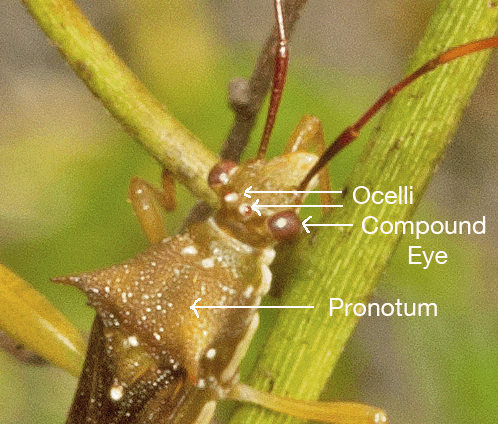






 On December 8, 2014, this 7 mm long broad-headed nymph was captured with a sweep net in the Smith Preserve's dry, seasonal marsh.
On December 8, 2014, this 7 mm long broad-headed nymph was captured with a sweep net in the Smith Preserve's dry, seasonal marsh.  On March 17, 2016, the family was identified by Ken Wolgemuth, a Contributing Editor of <BugGuide.net>.
On March 17, 2016, the family was identified by Ken Wolgemuth, a Contributing Editor of <BugGuide.net>. 
 On January 17, 2019, this tiny nymph, just 2.25 mm long, was found living in shredded palmetto fibers in the center area of the Smith Preserve, just North of Smith Preserve Way. The fibers were found in a clump on the ground by a Conservancy Science volunteer.
On January 17, 2019, this tiny nymph, just 2.25 mm long, was found living in shredded palmetto fibers in the center area of the Smith Preserve, just North of Smith Preserve Way. The fibers were found in a clump on the ground by a Conservancy Science volunteer. 



 On November 11, 2015, this 5 mm bug was observed on the pant leg of this webmaster as she was exiting the Smith Preserve.
On November 11, 2015, this 5 mm bug was observed on the pant leg of this webmaster as she was exiting the Smith Preserve.  These two photographs were taken and submitted to <BugGuide.net>, sponsored by Iowa State University Department of Entomology, for identification.
These two photographs were taken and submitted to <BugGuide.net>, sponsored by Iowa State University Department of Entomology, for identification.  On December 30, 2015, the 3.5 mm long bug at left and below was captured with a sweep net that was used along the east gopher tortoise fence, south of Smith Preserve Way.
On December 30, 2015, the 3.5 mm long bug at left and below was captured with a sweep net that was used along the east gopher tortoise fence, south of Smith Preserve Way.  On January 15, 2022, Ken Wolgemuth a Contributing Editor responded to the post with: "Blissidae? Body shape looks right, but it's hard to be sure when few details can be seen."
On January 15, 2022, Ken Wolgemuth a Contributing Editor responded to the post with: "Blissidae? Body shape looks right, but it's hard to be sure when few details can be seen." 
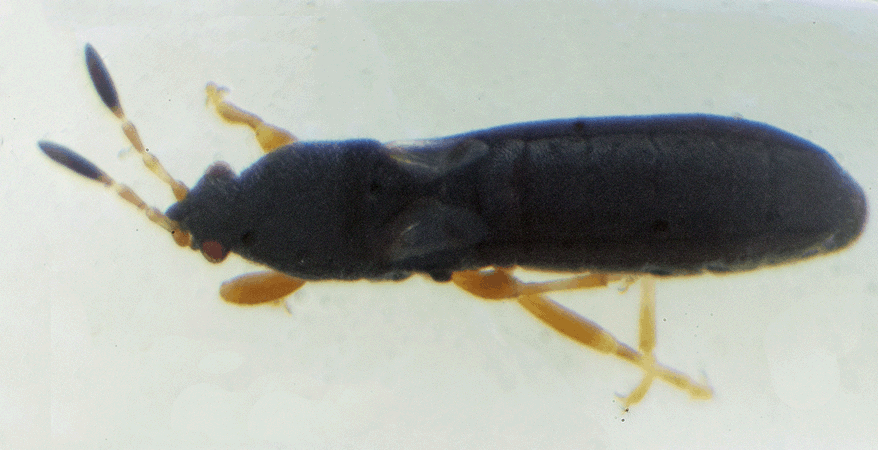


 On the morning of April 16, 2015, this 20 mm leaf-footed bug was spotted on
On the morning of April 16, 2015, this 20 mm leaf-footed bug was spotted on  The genus name, Acanthocephala means "spiny head" and describes the pointed tylus (the forward projecting lobe of the front of the head). The species name "femorata" refers to the swollen hind femurs on the male.
The genus name, Acanthocephala means "spiny head" and describes the pointed tylus (the forward projecting lobe of the front of the head). The species name "femorata" refers to the swollen hind femurs on the male.


 The Passionvine Bug is an example of a leaf-footed bug. These bugs have a leaf-like expanded part of its hind legs. In addition to having this leg structure, the species shown here has an oval shape like other members of Family Coreidae. Forewings have many veins and antennae have 4 segments. Several coreid species are pests of agricultural crops.
The Passionvine Bug is an example of a leaf-footed bug. These bugs have a leaf-like expanded part of its hind legs. In addition to having this leg structure, the species shown here has an oval shape like other members of Family Coreidae. Forewings have many veins and antennae have 4 segments. Several coreid species are pests of agricultural crops.

 This leaf-footed bug is 13 to 15 mm in length, slender. and elongate.
This leaf-footed bug is 13 to 15 mm in length, slender. and elongate.  The dorsal surface is a dull red color with many conspicuous dark punctures. The eyes, ventral surface, and legs are red. Antennae are dark brown, with contrasting lighter colors on some segments.
The dorsal surface is a dull red color with many conspicuous dark punctures. The eyes, ventral surface, and legs are red. Antennae are dark brown, with contrasting lighter colors on some segments.  These photographs show leaf-footed bug nymphs. These bugs often gather in large groups, as these did on a thistle in the Smith Preserve.
These photographs show leaf-footed bug nymphs. These bugs often gather in large groups, as these did on a thistle in the Smith Preserve. 

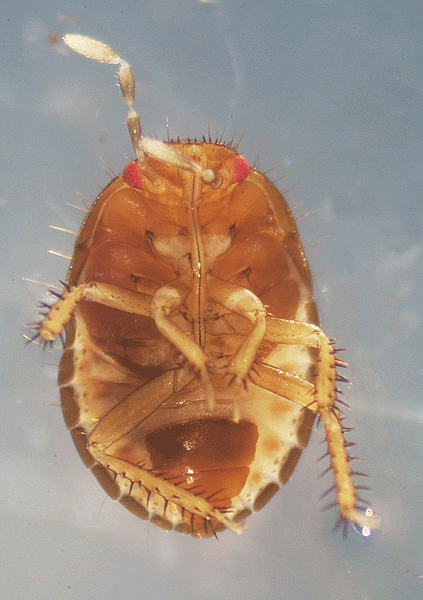




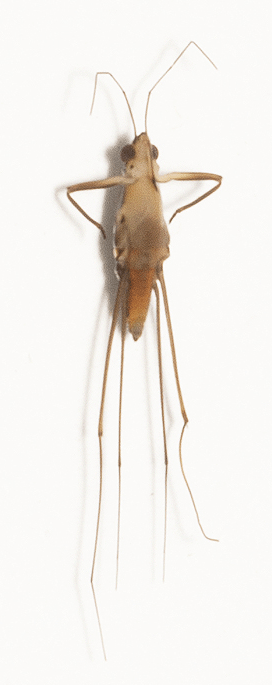




 Family Gerridae has several characteristics that help distinguish it from other families of heteropteans. Species have: 1) 4-segmented antenna; 2) no ocelli (simple eyes); 3) short front legs (see photograph 1); 4) long and slender middle and hind legs with the middle leg originating closer to the hind leg than to the front leg (see photograph 1); 5) a body covered by short, soft, water-repelling hairs; and 6) the ability to skate, glide, and dart on top of water surfaces. Gerrids may or not have wings.
Family Gerridae has several characteristics that help distinguish it from other families of heteropteans. Species have: 1) 4-segmented antenna; 2) no ocelli (simple eyes); 3) short front legs (see photograph 1); 4) long and slender middle and hind legs with the middle leg originating closer to the hind leg than to the front leg (see photograph 1); 5) a body covered by short, soft, water-repelling hairs; and 6) the ability to skate, glide, and dart on top of water surfaces. Gerrids may or not have wings. 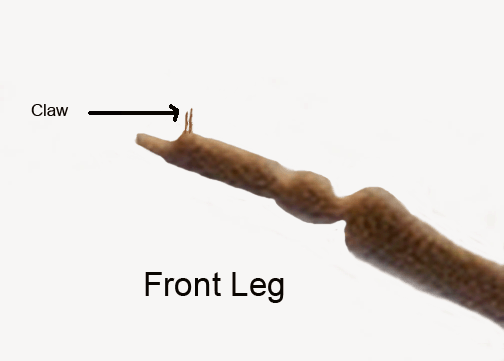 As shown in photograph 2, front legs have claws that are preapical (not at the end of the legs). Because of the claw location, claws do not break the surface tension of the water. The front legs have at least three functions for the water strider: 1) claws are used to puncture prey; 2) sense organs on the legs detect ripples produced by struggling prey; 3) muscles push the water surface, creating ripples to define its territory. Even though individuals make their presence known through repel, ripple signals, they often live in large groups.
As shown in photograph 2, front legs have claws that are preapical (not at the end of the legs). Because of the claw location, claws do not break the surface tension of the water. The front legs have at least three functions for the water strider: 1) claws are used to puncture prey; 2) sense organs on the legs detect ripples produced by struggling prey; 3) muscles push the water surface, creating ripples to define its territory. Even though individuals make their presence known through repel, ripple signals, they often live in large groups.  The water striders shown in these photographs, captured in a dipnet sample of pond water at the Christopher B. Smith Preserve on November 20, 2013, were identified using Identification Manual for the Aquatic and Semi-Aquatic Heteroptera of Florida. Epler, J.H.; 2006.
The water striders shown in these photographs, captured in a dipnet sample of pond water at the Christopher B. Smith Preserve on November 20, 2013, were identified using Identification Manual for the Aquatic and Semi-Aquatic Heteroptera of Florida. Epler, J.H.; 2006. Water striders are both predators and scavengers, eating tadpoles, mosquito larvae, eggs, and dead insects. Once food is found, the water strider uses its beak (shown in photograph 4) to pierce the prey and inject digestive juices that dissolve and liquefy internal organs. It then sucks out nourishment.
Water striders are both predators and scavengers, eating tadpoles, mosquito larvae, eggs, and dead insects. Once food is found, the water strider uses its beak (shown in photograph 4) to pierce the prey and inject digestive juices that dissolve and liquefy internal organs. It then sucks out nourishment. 


 On January 11, 2017, two ~1.5 BL water strider nymphs were captured in a net in the Smith Preserve Marsh by Leif Johnson, a Conservancy of SW Florida scientist.
On January 11, 2017, two ~1.5 BL water strider nymphs were captured in a net in the Smith Preserve Marsh by Leif Johnson, a Conservancy of SW Florida scientist. 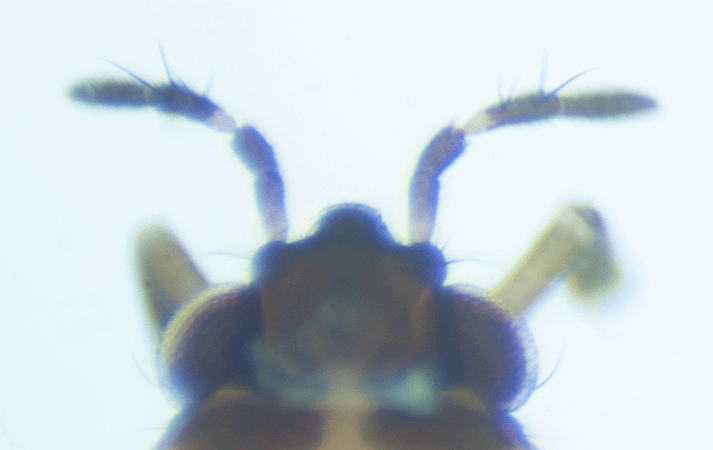





 There are seven Hydrometra species in the United States. The individuals shown in these photographs were captured in a dipnet sample at the Christopher B. Smith Preserve on November 20, 2013.
There are seven Hydrometra species in the United States. The individuals shown in these photographs were captured in a dipnet sample at the Christopher B. Smith Preserve on November 20, 2013.  Hydrometra australis has three characteristics that separate it from the rest of the species: 1) photograph two shows it has two pits on the acetabula (cavities in which the front and middle legs are inserted), 2) photograph three shows the 2nd antennal segment is 2.5 or more times the length of segment one, and 3) there are exaggerated outlines of the terminal segments of the abdomen.
Hydrometra australis has three characteristics that separate it from the rest of the species: 1) photograph two shows it has two pits on the acetabula (cavities in which the front and middle legs are inserted), 2) photograph three shows the 2nd antennal segment is 2.5 or more times the length of segment one, and 3) there are exaggerated outlines of the terminal segments of the abdomen.  Water-measurers stand on stilt-like legs, that are sensitive to vibrations of the water's surface.
Water-measurers stand on stilt-like legs, that are sensitive to vibrations of the water's surface.


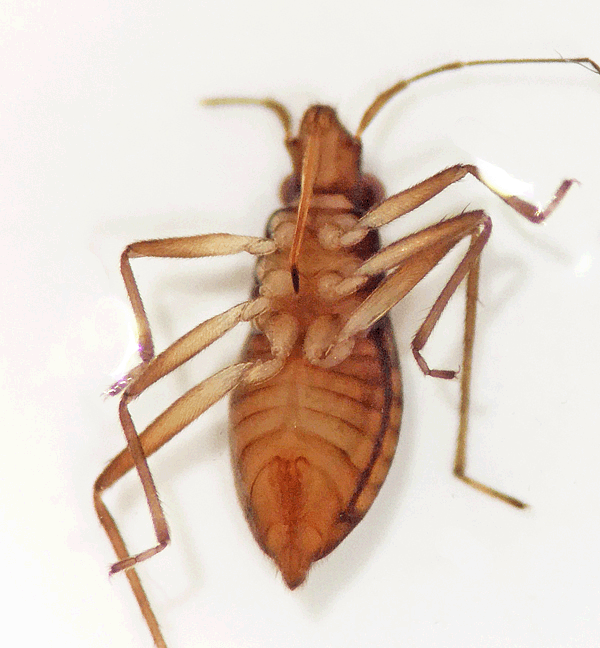


 On January 30, 2017, the species was identified by the webmaster using J.H. Epler's Identification Manual for the Aquatic and Semi-Aquatic Heteroptera of Florida, 8.3.
On January 30, 2017, the species was identified by the webmaster using J.H. Epler's Identification Manual for the Aquatic and Semi-Aquatic Heteroptera of Florida, 8.3. 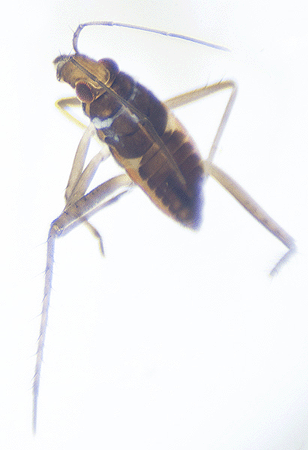
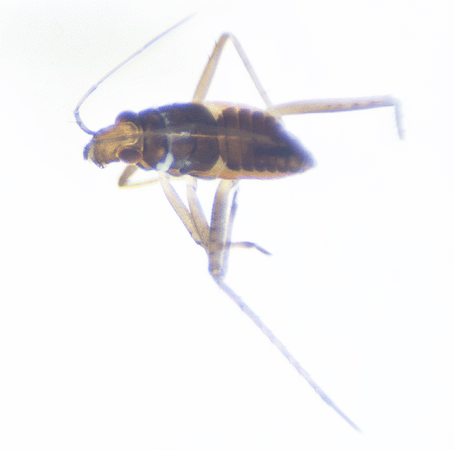

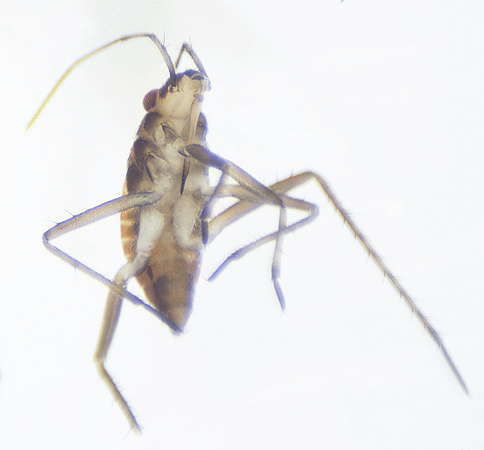
 Both photographs of this individual are courtesy of Dr. Pintar.
Both photographs of this individual are courtesy of Dr. Pintar. 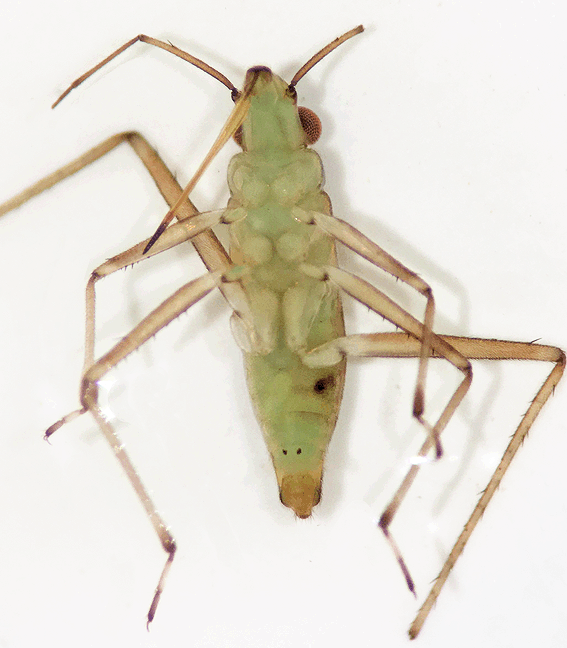

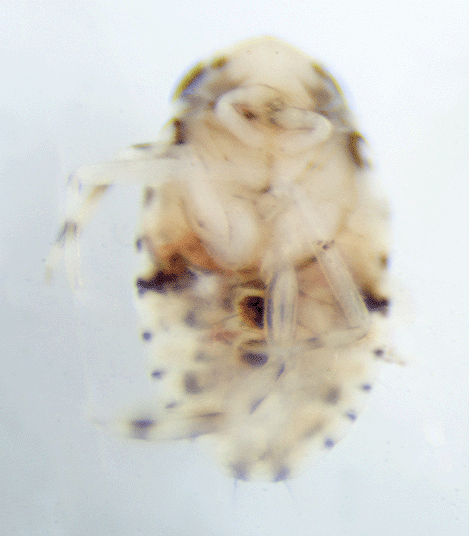
 Worldwide, there are 10,000 species in Family Miridae. This number makes Family Miridae the largest family in the Suborder Heteroptera, and includes1/3 of all known Heteropteran species. There are 1800 species in the United States.
Worldwide, there are 10,000 species in Family Miridae. This number makes Family Miridae the largest family in the Suborder Heteroptera, and includes1/3 of all known Heteropteran species. There are 1800 species in the United States.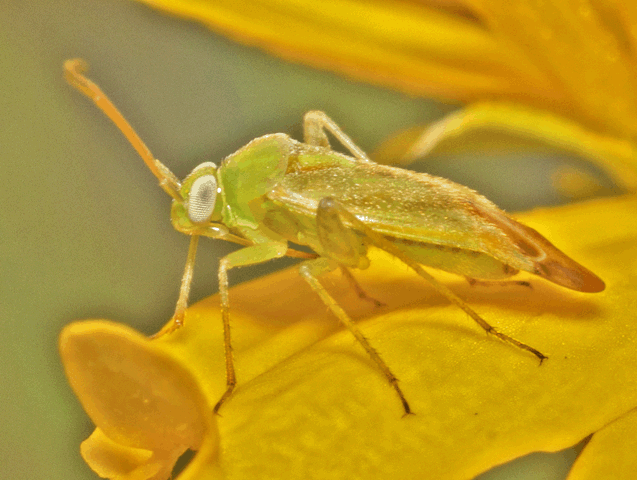

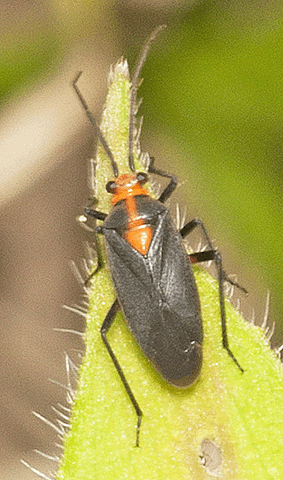 This unknown plant bug was photographed on
This unknown plant bug was photographed on 

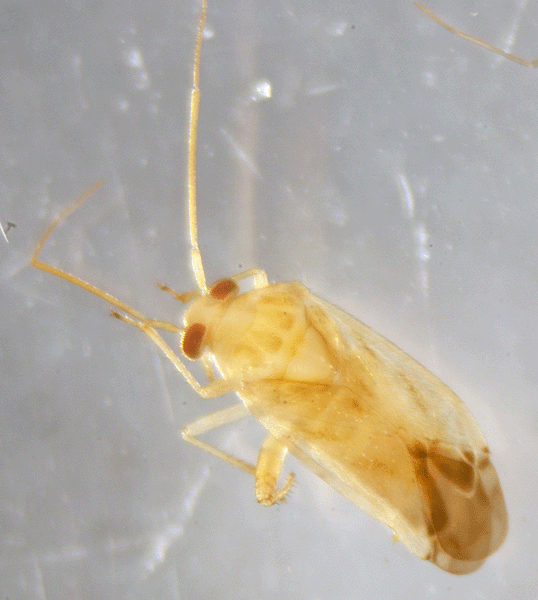
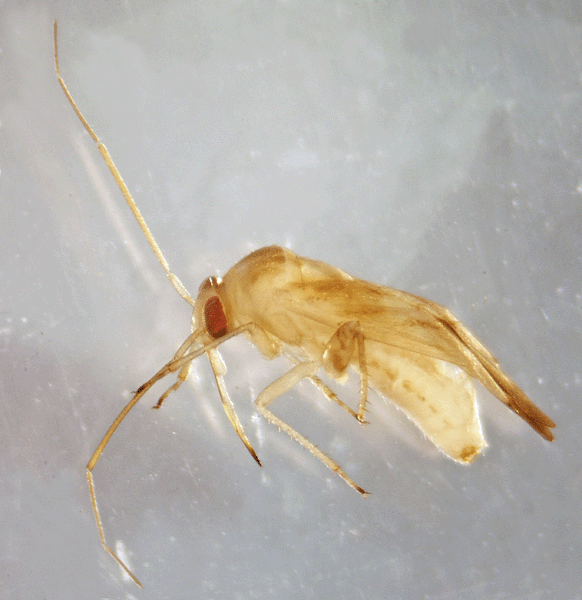




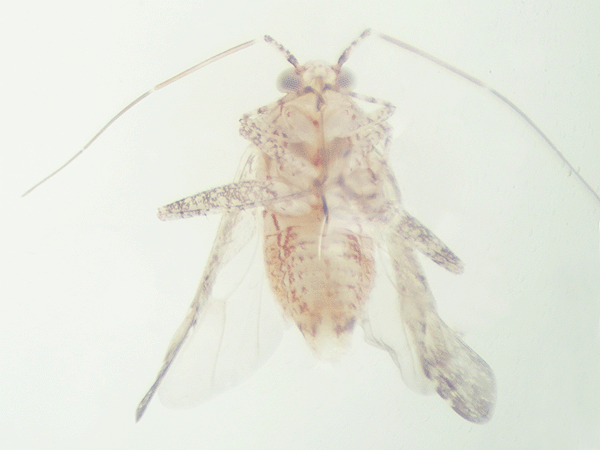
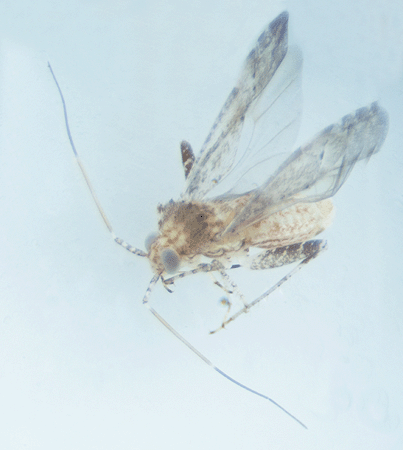 On January 25, 2019, this 3 mm long bug was living in
On January 25, 2019, this 3 mm long bug was living in  Note the well-developed hind jumping legs.
Note the well-developed hind jumping legs.  On August 27, 2021, Dr. Matthew Pintar, a Postdoctoral Associate from Florida International University, visited the Christopher B. Smith Preserve and collected specimens from the gopher tortoise preserve pond. One of his collected specimens was this Ranatra australis. These three photographs are courtesy of Dr. Pintar.
On August 27, 2021, Dr. Matthew Pintar, a Postdoctoral Associate from Florida International University, visited the Christopher B. Smith Preserve and collected specimens from the gopher tortoise preserve pond. One of his collected specimens was this Ranatra australis. These three photographs are courtesy of Dr. Pintar.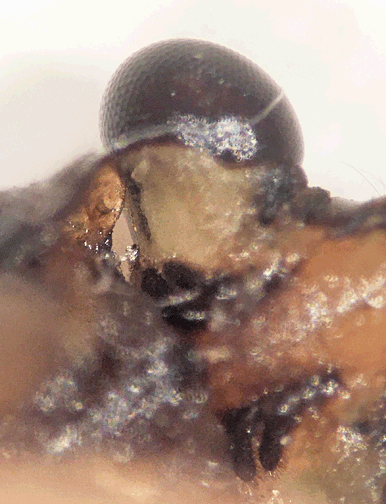


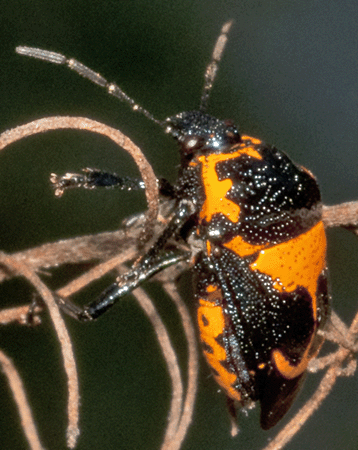



 Photograph three shows two nymphs.
Photograph three shows two nymphs. 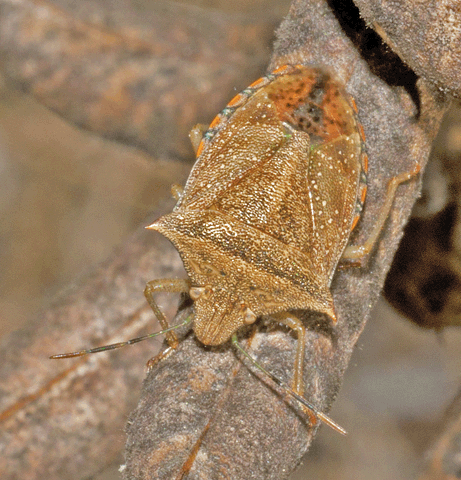

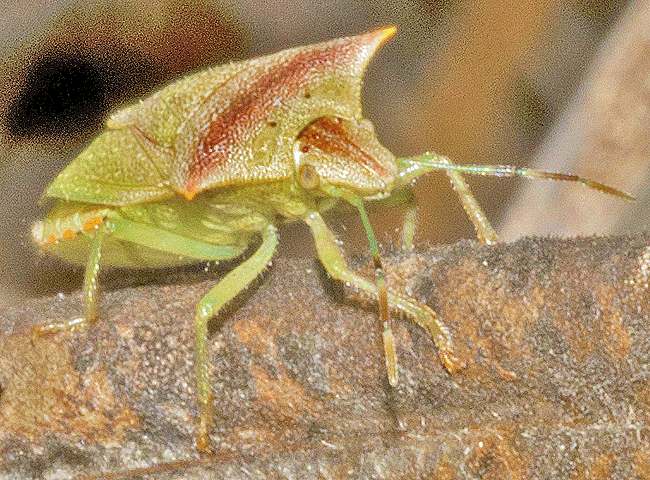

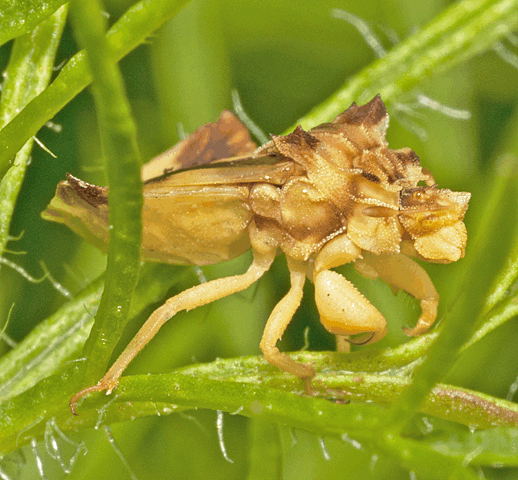
 Prey for ambush bugs include flies, bees, wasps, and moths attracted to flowers.
Prey for ambush bugs include flies, bees, wasps, and moths attracted to flowers. 

 On January 13, 2022, this 3.5 mm long (not including legs) bug was located under a piece of loose bark on a tree in the Preserve, south of the pond in a hammock, west of the maintenance building.
On January 13, 2022, this 3.5 mm long (not including legs) bug was located under a piece of loose bark on a tree in the Preserve, south of the pond in a hammock, west of the maintenance building. 
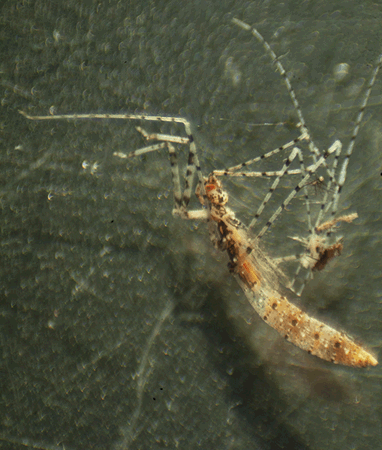

 Reduviidae is the second largest family in Suborder Heteroptera. There are 184 species in 49 genera found north of Mexico. The 65 species that live in Florida have diverse colors and forms, but have some structures in common.
Reduviidae is the second largest family in Suborder Heteroptera. There are 184 species in 49 genera found north of Mexico. The 65 species that live in Florida have diverse colors and forms, but have some structures in common. As shown in the second photograph, all Florida assassin bugs have curved, 3-segmented beaks. When not in use, the beak fits into a groove between the two front legs. The beak is used to stab and inject venom into prey. Venom paralyzes the prey. Care should be taken when handling these insects because many species can inflict a painful bite to humans.
As shown in the second photograph, all Florida assassin bugs have curved, 3-segmented beaks. When not in use, the beak fits into a groove between the two front legs. The beak is used to stab and inject venom into prey. Venom paralyzes the prey. Care should be taken when handling these insects because many species can inflict a painful bite to humans. Some assassin bugs, like the one in these photographs, have enlarged forelegs which help in catching prey.
Some assassin bugs, like the one in these photographs, have enlarged forelegs which help in catching prey. 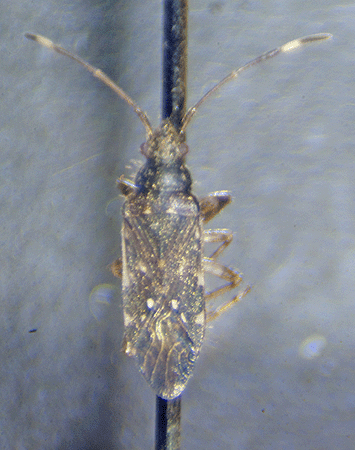

 On January 23, 2017, this 5.75 mm long bug was living in leaf litter beneath a
On January 23, 2017, this 5.75 mm long bug was living in leaf litter beneath a  This 4 mm long bug was caught in a sweep net in the dry marsh in November 2012. Photographs were prepared using photomicroscopy.
This 4 mm long bug was caught in a sweep net in the dry marsh in November 2012. Photographs were prepared using photomicroscopy. 
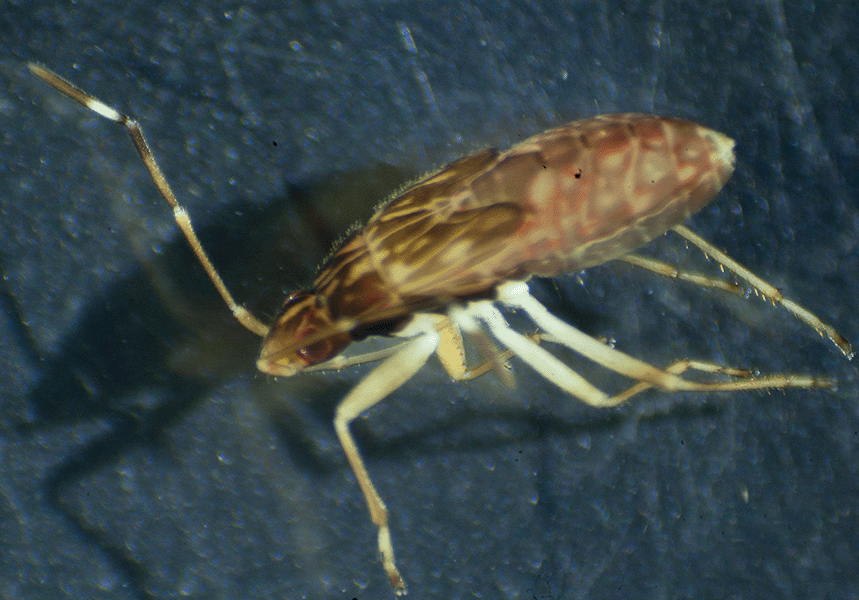
 On April 15, 2023, the family was positively identified by Ken Wolgemuth, a Contributing Editor to <Bugguide.net.> As was explained above, members of the family have enlarged fore femora, are small, and mottled in shades of brown. Wolgemuth stated, "Maybe Ozophora." He included a photograph of an adult that was posted at <Bugguide.net.
On April 15, 2023, the family was positively identified by Ken Wolgemuth, a Contributing Editor to <Bugguide.net.> As was explained above, members of the family have enlarged fore femora, are small, and mottled in shades of brown. Wolgemuth stated, "Maybe Ozophora." He included a photograph of an adult that was posted at <Bugguide.net.

 These images were created using photomicroscopy and sent for identification to <Bugguide.net>, sponsored by Iowa State University's Department of Entomology.
These images were created using photomicroscopy and sent for identification to <Bugguide.net>, sponsored by Iowa State University's Department of Entomology. 



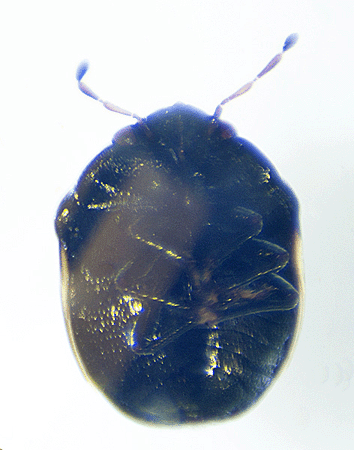

 On February 18, 2020, this lace bug was removed from a yellow bowl trap that had been left overnight in a sandy scrub area south of the pond and just west of the gopher tortoise fence in the Christopher B. Smith Preserve.
On February 18, 2020, this lace bug was removed from a yellow bowl trap that had been left overnight in a sandy scrub area south of the pond and just west of the gopher tortoise fence in the Christopher B. Smith Preserve.  On February 19, 2020, the genus was identified by Ken Wolgemuth, a Contributing Editor to <BugGuide.net>.
On February 19, 2020, the genus was identified by Ken Wolgemuth, a Contributing Editor to <BugGuide.net>.  On December 29, 2014, this 2 mm long lace bug was living in pine needle litter beneath a
On December 29, 2014, this 2 mm long lace bug was living in pine needle litter beneath a 
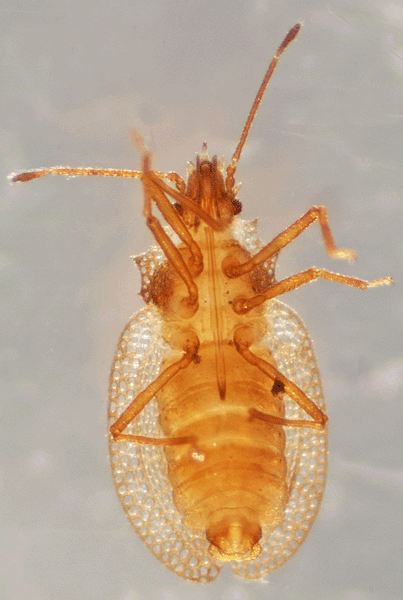





 All members of Family Veliidae are called "small water striders." Characteristics of the family include: 5 mm or less in length, 4-segmented antennae, no ocelli, thorax wider than abdomen, and front tarsal cleft with claws arising before the tips (as shown in the second photograph).
All members of Family Veliidae are called "small water striders." Characteristics of the family include: 5 mm or less in length, 4-segmented antennae, no ocelli, thorax wider than abdomen, and front tarsal cleft with claws arising before the tips (as shown in the second photograph).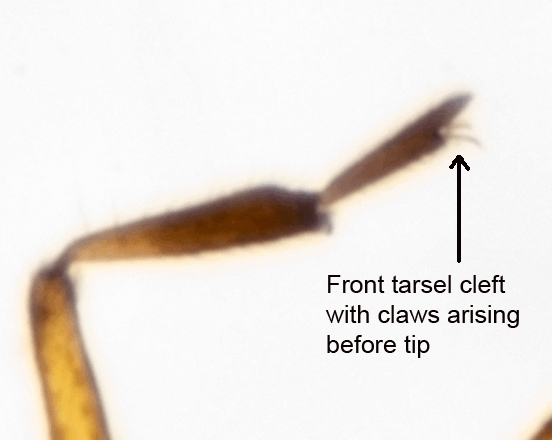

 Adults have wings and can fly to new locations.
Adults have wings and can fly to new locations. 

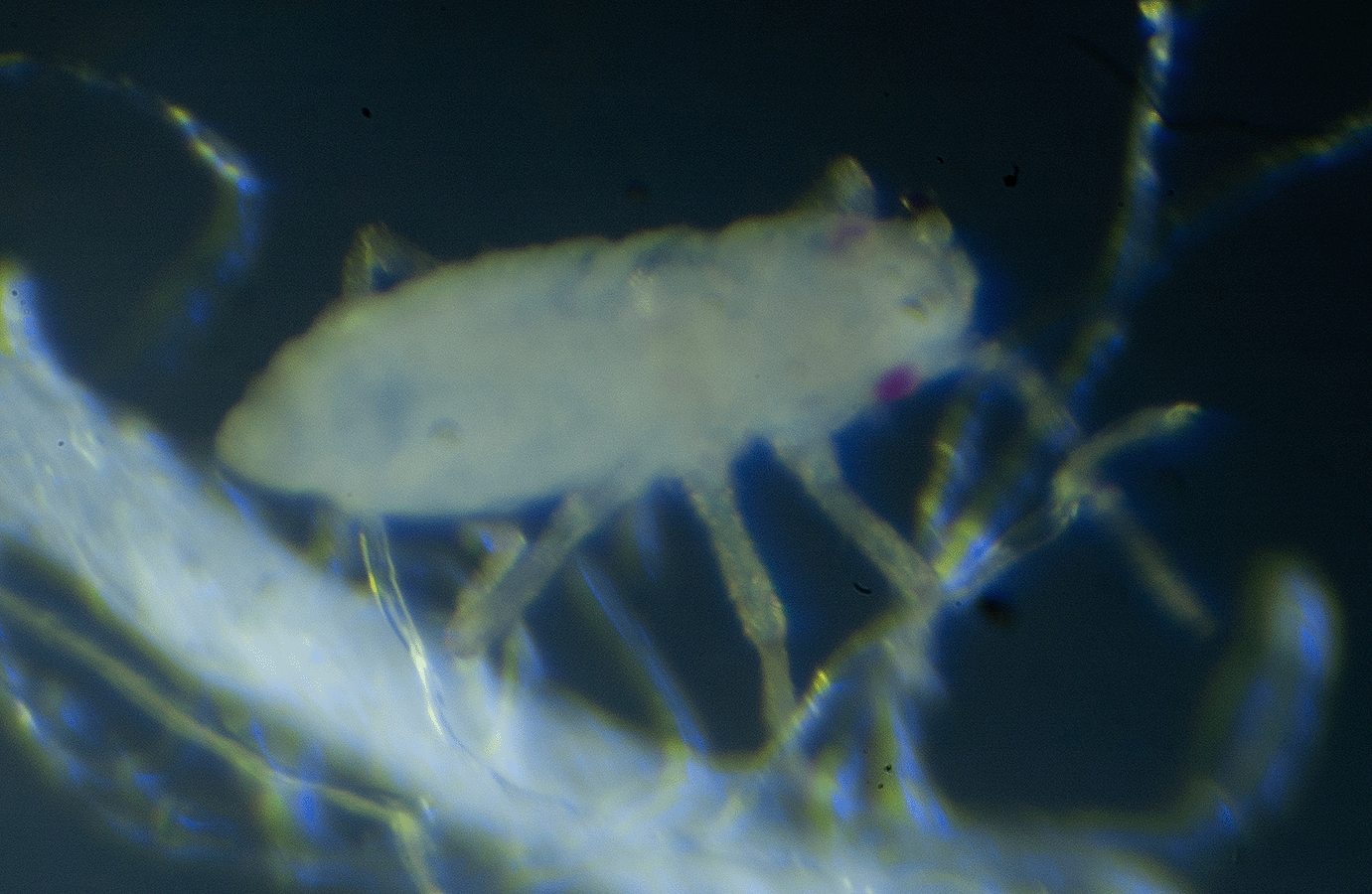
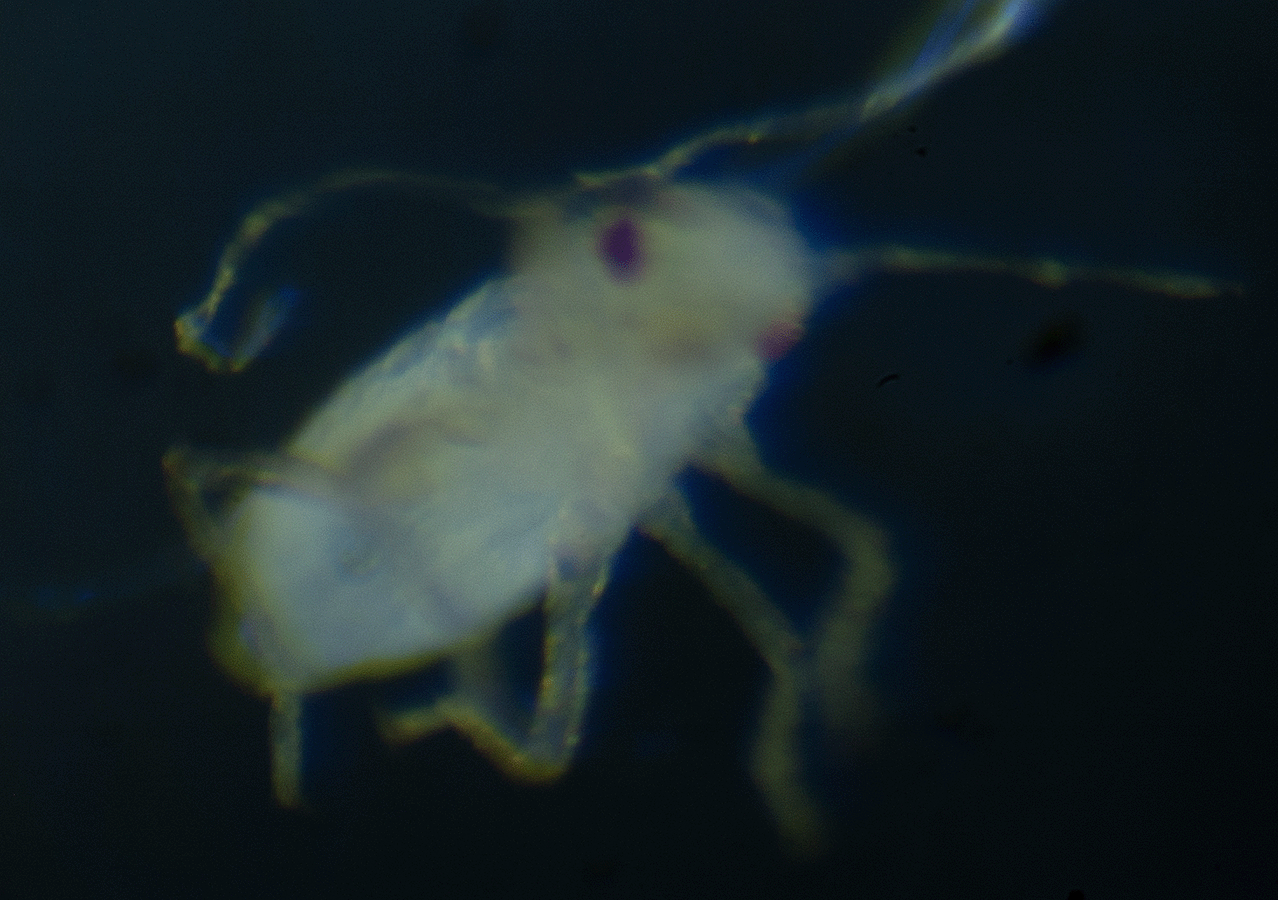




 On March 30, 2024, the genus was identified by Solomon Hendrix, a Contributing Editor of <Bugguide.net>.
On March 30, 2024, the genus was identified by Solomon Hendrix, a Contributing Editor of <Bugguide.net>. 








 As shown in the first two photographs, Family Cercopidae are most easily recognized by the froth of bubbles they produce on vegetation. Nymphs create these bubbles to hide inside, and the spittle prevents the nymph from drying out.
As shown in the first two photographs, Family Cercopidae are most easily recognized by the froth of bubbles they produce on vegetation. Nymphs create these bubbles to hide inside, and the spittle prevents the nymph from drying out. 




























 On March 6, 2012, this adult green leafhopper was on a
On March 6, 2012, this adult green leafhopper was on a On December 30, 2015, this adult 4.5 mm long leafhopper was captured in a sweep net sample taken in low brush growing adjacent to the eastern fence of the Smith Preserve north of Smith Preserve way.
On December 30, 2015, this adult 4.5 mm long leafhopper was captured in a sweep net sample taken in low brush growing adjacent to the eastern fence of the Smith Preserve north of Smith Preserve way.  As can be seen in these photographs, this green leafhopper has a distinctive pattern of black dots and lines on top of it head, black markings on the anterior half of the pronotum, and several small black dots and lines on the triangular scutellum. There are several longitudinal lines running along the length of the forewing, and there is a band of clear cells at the apex of the forewing. The frontal part of the pronotum, abdomen, and legs have a yellowish color.
As can be seen in these photographs, this green leafhopper has a distinctive pattern of black dots and lines on top of it head, black markings on the anterior half of the pronotum, and several small black dots and lines on the triangular scutellum. There are several longitudinal lines running along the length of the forewing, and there is a band of clear cells at the apex of the forewing. The frontal part of the pronotum, abdomen, and legs have a yellowish color.  The species ranges from Florida to the northern half of South America. Habitat includes vegetation surrounding sugar cane plantations, citrus orchards, and commercial bean fields. Individuals may damage citrus trees and are a vector of a virus of rice in Central and South America, causing yellow leaves, stunted growth, and sterile flowers in rice.
The species ranges from Florida to the northern half of South America. Habitat includes vegetation surrounding sugar cane plantations, citrus orchards, and commercial bean fields. Individuals may damage citrus trees and are a vector of a virus of rice in Central and South America, causing yellow leaves, stunted growth, and sterile flowers in rice. 




 On December 30, 2015, this 5 mm long leafhopper nymph was captured in a sweep net sample taken in low brush growing along the eastern fence just north of Smith Preserve Way. These photographic images were prepared using photomicroscopy and sent for identification to <BugGuide.net>, sponsored by Iowa State University Department of Entomology.
On December 30, 2015, this 5 mm long leafhopper nymph was captured in a sweep net sample taken in low brush growing along the eastern fence just north of Smith Preserve Way. These photographic images were prepared using photomicroscopy and sent for identification to <BugGuide.net>, sponsored by Iowa State University Department of Entomology.
















 On January 16, 2016, this adult 2.75 mm long lemon-yellow leafhopper adult with blue eyes was captured with a sweep net. At the time, the leafhopper was perched on a
On January 16, 2016, this adult 2.75 mm long lemon-yellow leafhopper adult with blue eyes was captured with a sweep net. At the time, the leafhopper was perched on a 


 These photographs were created using photomicroscopy and sent for identification to <BugGuide.net>, sponsored by Iowa State University's Department of Entomology.
These photographs were created using photomicroscopy and sent for identification to <BugGuide.net>, sponsored by Iowa State University's Department of Entomology. 
 On December 30, 2015, this 3 mm long adult leafhopper was captured with a sweep net in grasses growing on the south side of the Smith Preserve Pond.
On December 30, 2015, this 3 mm long adult leafhopper was captured with a sweep net in grasses growing on the south side of the Smith Preserve Pond. .gif)






 On April 1, 2024, the genus was identified by Solomon Hendrix, a Contributing Editor of <Bugguide.net>.
On April 1, 2024, the genus was identified by Solomon Hendrix, a Contributing Editor of <Bugguide.net>. 

 In our area, there are 13 families, 170 genera, and 900 species in this Superfamily. According to <BugGuide.net> (and shown in this close-up), all have antennae inserted on the side of the "cheeks" below the eyes and the antennae have three segments, the basal two are thickened and round or egg-shaped, the second segment bears the third segment, a fine filamentous arista.
In our area, there are 13 families, 170 genera, and 900 species in this Superfamily. According to <BugGuide.net> (and shown in this close-up), all have antennae inserted on the side of the "cheeks" below the eyes and the antennae have three segments, the basal two are thickened and round or egg-shaped, the second segment bears the third segment, a fine filamentous arista. 














 This 1.5 mm insect was caught in a sweep net sample obtained in the dry, grassy marsh at the Smith Preserve on December 8, 2014.
This 1.5 mm insect was caught in a sweep net sample obtained in the dry, grassy marsh at the Smith Preserve on December 8, 2014. On December 8, 2014, this 3.5 mm long planthopper was captured in a sweep net in the Smith Preserve's dry, seasonal marsh.
On December 8, 2014, this 3.5 mm long planthopper was captured in a sweep net in the Smith Preserve's dry, seasonal marsh.  On August 7, 2016, the genus was identified by John S. Ascher, a Contributing Editor to <BugGuide.net>.
On August 7, 2016, the genus was identified by John S. Ascher, a Contributing Editor to <BugGuide.net>.  On November 21, 2012, this hopper was photographed in the Smith Preserve on a leaflet of
On November 21, 2012, this hopper was photographed in the Smith Preserve on a leaflet of 

 On December 4, 2017, this planthopper was photographed as it rested on a branch in the northeast quadrant of the Smith Preserve.
On December 4, 2017, this planthopper was photographed as it rested on a branch in the northeast quadrant of the Smith Preserve.  These palm flatid planthoppers had just completed molting when they were spotted in the Smith Preserve on April 30, 2014. The species was recognized from these images on January 25, 2015 by Ken Wolgemuth, Contributing Editor of <BugGuide.net>, sponsored by Iowa State University Department of Entomology.
These palm flatid planthoppers had just completed molting when they were spotted in the Smith Preserve on April 30, 2014. The species was recognized from these images on January 25, 2015 by Ken Wolgemuth, Contributing Editor of <BugGuide.net>, sponsored by Iowa State University Department of Entomology.



 Treehoppers are a group of insects related to cicadas and leafhoppers. There are about 3,200 species of treehoppers known. All have an enlarged pronotum (the dorsal portion of the first thoracic segment).
Treehoppers are a group of insects related to cicadas and leafhoppers. There are about 3,200 species of treehoppers known. All have an enlarged pronotum (the dorsal portion of the first thoracic segment). As can be seen in the 2nd photograph (a top view of this treehopper), the enlarged pronotum comes to a point behind each of this treehopper's pink eyes.
As can be seen in the 2nd photograph (a top view of this treehopper), the enlarged pronotum comes to a point behind each of this treehopper's pink eyes.


 On December 13, 2016, this 3 mm long, immature planthopper was captured in a yellow bowl trap left overnight in the Smith Preserve near 14th Ave N and a private residence.
On December 13, 2016, this 3 mm long, immature planthopper was captured in a yellow bowl trap left overnight in the Smith Preserve near 14th Ave N and a private residence. 




 In order to isolate the invertebrates, the fibers were collected and placed in a Berlese funnel.
In order to isolate the invertebrates, the fibers were collected and placed in a Berlese funnel. 







 On December 13, 2016, this 1.1 mm long insect was captured in a yellow bowl trap left overnight in the southern portion of the Smith Preserve near 14th Ave N and a private residence.
On December 13, 2016, this 1.1 mm long insect was captured in a yellow bowl trap left overnight in the southern portion of the Smith Preserve near 14th Ave N and a private residence. 








 Florida has at least 75 species of aphids. Several different species are shown below in these photographs.
Florida has at least 75 species of aphids. Several different species are shown below in these photographs. 









 On December 30, 2015, this 1 mm long aphid was captured with a sweep net in the high grasses and other vegetation growing along the southern edge of the Smith Preserve Pond.
On December 30, 2015, this 1 mm long aphid was captured with a sweep net in the high grasses and other vegetation growing along the southern edge of the Smith Preserve Pond.  After seeing the photograph, Natalie responded, "Yep. Definitely Drepanaphis. I'm not sure on species, I've only collected a few and there are several in the genus, but definitely Drepanaphis. I'll try to remember to take a look in my key and see if I can ID species."
After seeing the photograph, Natalie responded, "Yep. Definitely Drepanaphis. I'm not sure on species, I've only collected a few and there are several in the genus, but definitely Drepanaphis. I'll try to remember to take a look in my key and see if I can ID species."










 The bottom surface of adult females are covered with oval, reddish-orange eggs. In
The bottom surface of adult females are covered with oval, reddish-orange eggs. In

 The pine tortoise scale is one of two scales found on
The pine tortoise scale is one of two scales found on Both scales feed by piercing the plant and sucking sap. As a result, they produce large amounts of honeydew. Sooty mold often lives on the honeydew, causing the tree to have a black, fuzzy appearance.
Both scales feed by piercing the plant and sucking sap. As a result, they produce large amounts of honeydew. Sooty mold often lives on the honeydew, causing the tree to have a black, fuzzy appearance. 
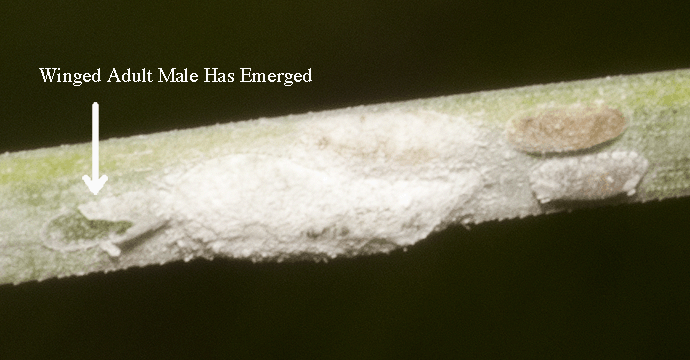

 On November 20, 2014, scales were photographed on a
On November 20, 2014, scales were photographed on a  Large numbers of these scales give twigs a warty appearance.
Large numbers of these scales give twigs a warty appearance. 
 The identification was made by Dr. Buss. In his e-mail, he stated, "These are likely pine scales, Chionaspis heteroflexible
The identification was made by Dr. Buss. In his e-mail, he stated, "These are likely pine scales, Chionaspis heteroflexible






 These photographs were created using photomicroscopy. The first image is a dorsal view, the second is a ventral view, and the third is a closer dorsal view of its head. Note the eyes and bristled antennae.
These photographs were created using photomicroscopy. The first image is a dorsal view, the second is a ventral view, and the third is a closer dorsal view of its head. Note the eyes and bristled antennae.















 On February 17, 2016, several Citrus X meyeri (Meyer lemons) were picked from one of the citrus trees growing in the middle of the Smith Preserve. Upon examination, the fruit had several patches of white scales.
On February 17, 2016, several Citrus X meyeri (Meyer lemons) were picked from one of the citrus trees growing in the middle of the Smith Preserve. Upon examination, the fruit had several patches of white scales.  The white scales shown in these photographs are armored immature males. Once the male crawlers hatch from eggs, they begin feeding and become immobile. They develop through several stages, finally to emerge as bright orange, winged adults from the pupal stage. Adult males do not eat. Their main function is to mate.
The white scales shown in these photographs are armored immature males. Once the male crawlers hatch from eggs, they begin feeding and become immobile. They develop through several stages, finally to emerge as bright orange, winged adults from the pupal stage. Adult males do not eat. Their main function is to mate. Diaspididae is the largest family of scale insects. Within the family, there are 400 genera and more than 2,650 species.
Diaspididae is the largest family of scale insects. Within the family, there are 400 genera and more than 2,650 species.  The scales in the photograph are white armored scales. The species is either Duplachionaspis divergens or Haliaspis sp.
The scales in the photograph are white armored scales. The species is either Duplachionaspis divergens or Haliaspis sp. 








 Kermes scales are pests of Quercus spp. (Oaks) throughout the northern hemisphere. There are 32 species in North America and Mexico. The adult females of these species look like
Kermes scales are pests of Quercus spp. (Oaks) throughout the northern hemisphere. There are 32 species in North America and Mexico. The adult females of these species look like 
















 On December 19, 2014, this 1.25 mm long male scale was living in leaf litter that was collected under a citrus tree in the northeastern hammock of the Smith Preserve.
On December 19, 2014, this 1.25 mm long male scale was living in leaf litter that was collected under a citrus tree in the northeastern hammock of the Smith Preserve. 












 The body of a coconut mealybug is maroon, reddish-brown, or orange and covered with wax. Adult females are 1.5 to 2.5 mm, round to oval, with lateral and dorsal wax filaments (as shown in this photograph.) Females do not produce ovisacs. Winged adult males are common, but are not present in this photograph.
The body of a coconut mealybug is maroon, reddish-brown, or orange and covered with wax. Adult females are 1.5 to 2.5 mm, round to oval, with lateral and dorsal wax filaments (as shown in this photograph.) Females do not produce ovisacs. Winged adult males are common, but are not present in this photograph.  On December 19, 2014, these mealybugs were living in leaf litter under a citrus tree in the hammock located in the northeast corner of the Smith Preserve. They were extracted from the leaf litter using a Berlese funnel. Photographs were produced using photomicroscopy
On December 19, 2014, these mealybugs were living in leaf litter under a citrus tree in the hammock located in the northeast corner of the Smith Preserve. They were extracted from the leaf litter using a Berlese funnel. Photographs were produced using photomicroscopy The orange individual shown here was 1.25 mm long. The first view of that individual is a dorsal view, the second view is a ventral view. Both photographs of the yellow individual are ventral views.
The orange individual shown here was 1.25 mm long. The first view of that individual is a dorsal view, the second view is a ventral view. Both photographs of the yellow individual are ventral views. 







